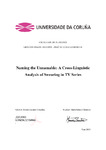Mostrar o rexistro simple do ítem
Naming the Unnamable: A Cross-Linguistic Analysis of Swearing in TV Series
| dc.contributor.advisor | Lezcano, Emma | |
| dc.contributor.author | Santos Cabarcos, María | |
| dc.contributor.other | Universidade da Coruña. Facultade de Filoloxía | es_ES |
| dc.date.accessioned | 2023-11-14T11:08:00Z | |
| dc.date.available | 2023-11-14T11:08:00Z | |
| dc.date.issued | 2023 | |
| dc.identifier.uri | http://hdl.handle.net/2183/34199 | |
| dc.description.abstract | [Abstracts] In this project, a comparative analysis of bad language in television series is carried out. Two English and one Spanish series have been chosen to observe the differences in translation that occur between the two languages. The aim is to analyze not only the English and Spanish subtitles, but also the dubbed version. Offensive language is one of the most problematic issues for translators and maintaining intentionality is a difficult task considering the cultural differences between English and Spanish. Thus, this study provides a theoretical framework which explains not only the particularities of audiovisual translation, but also of bad language. In addition, the different translation strategies used to achieve an effective transfer between the two languages are also presented to observe how the different problems that arise when translating are solved. It should be considered that offensive language is used especially in informal situations. Consequently, it is more frequent to find a higher number of examples in spoken language. For this reason, series have been selected to observe the behavior of this linguistic phenomenon. Moreover, the selected series are characterized by a high degree of co-occurrence of this type of expressions, as well as by a quality translation that facilitates the extraction of data and conclusions. The most representative examples collected from a corpus consisting of 3 series and 39 chapters are shown. In total, 296 elements have been analyzed and are presented classified by translation strategies. The purpose of this study is to determine in which language there are more swear words, which translation strategies are most used, and which offensive categories appear most often, as well as what happens to the offensive charge: whether it is maintained, disappears, increases, or decreases. Therefore, the differences and similarities between the two languages regarding the translation of bad language in television series are revealed | es_ES |
| dc.language.iso | eng | es_ES |
| dc.rights | Os titulares dos dereitos de propiedade intelectual autorizan a visualización do contido deste traballo a través de Internet, así como a súa reproducción, gravación en soporte informático ou impresión para o seu uso privado e/ou con fins de estudo e de investigación. En nengún caso se permite o uso lucrativo deste documento. Estos dereitos afectan tanto ó resumo do traballo como o seu contido Los titulares de los derechos de propiedad intelectual autorizan la visualización del contenido de este trabajo a través de Internet, así como su repoducción, grabación en soporte informático o impresión para su uso privado o con fines de investigación. En ningún caso se permite el uso lucrativo de este documento. Estos derechos afectan tanto al resumen del trabajo como a su contenido | es_ES |
| dc.subject | Audiovisual translation | es_ES |
| dc.subject | Subtitling | es_ES |
| dc.subject | Dubbing | es_ES |
| dc.subject | Swearing | es_ES |
| dc.subject | Comparative analysis. | es_ES |
| dc.title | Naming the Unnamable: A Cross-Linguistic Analysis of Swearing in TV Series | es_ES |
| dc.type | info:eu-repo/semantics/bachelorThesis | es_ES |
| dc.rights.access | info:eu-repo/semantics/openAccess | es_ES |
| dc.description.traballos | Traballo fin de grao (UDC.FIL). Inglés: estudios lingüísticos y literarios. Curso 2022/2023 | es_ES |






